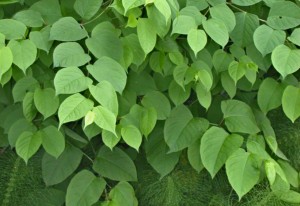Do you know how to get rid of Japanese knotweed?
Japanese knotweed was first introduced to North America in the late 19th century for ornamental use, which actually is understandable. Its hollow red tinged stems have distinct raised joints (nodes) that remind me a little of bamboo although it is not at all related. In fact, other common names for the plant are American bamboo and Mexican bamboo.

Japanese knotweed spreads quickly and forms dense thickets that exclude native vegetation. It poses a significant threat to riparian areas.
At the end of August the plant produces clusters of cream-colored flowers. The plant is quite attractive — at least on the surface. But oh once it’s established, kind of like the endless reruns of I Love Lucy only not so funny, Japanese knotweed just will not go away.
Ecological Threat
The problem is Japanese knotweed doesn’t have any natural enemies in the North Santiam Canyon, so once established, knotweed stands are are almost impossible to get rid of.
On top of that it spreads quickly, well quickly isn’t the word — too tame. I mean, the first time I saw this plant, I leaned over to get a closer look. Before I knew it the dang thing poked me in the eye, it grew so fast.
You need to be careful with Japanese knotweed. It thrives whenever it gets a toehold on sunny, moist areas — like creek and river banks. Worst of all, it forms a dense underground network of roots that choke out our native vegetation.
How to Get Rid of Japanese Knotweed
Did I mention it ‘s almost impossible to get rid of Japanese knotweed once it’s established? To eradicate the plant you’ll need to kill the roots. Not most of the roots, not stress the root, you need to kill every last fragment as dead as a doornail.
Don’t try digging. All it takes is a piece of rhizome (root) the size of your baby fingernail and it’ll be back. And it isn’t uncommon for the roots to spread up to 15 feet, maybe more in each direction and as deep as 9 feet. So really, don’t try digging it out. It isn’t likely to work.
Hitting the plant hard with herbicides doesn’t really work either. Spraying kills the tops sure enough, but before the herbicide acts on the deeper roots, Japanese knotweed goes dormant. And stays dormant for a couple of seasons. Then just as soon as you think you’ve got it licked….. it’s back.
Gradual poisoning of Japanese knotweed gives better long-term results than frequent, strong chemical applications. The above-ground portions of the plant need to be controlled with herbicide again and again, year after year to gradually weaken and eventually eradicate the patch.
